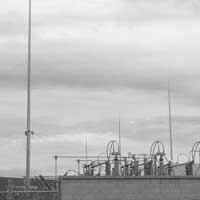
External (radiated, airborne) radio frequency noise can be classified according to its origin as being either natural or man made. Natural radio-noise sources include thunderstorms, lightning, cyclones, electron acceleration and emission processes in the magnetosphere, the sun and radiostars (such as the supernova remnant Cassiopeia A) Man made radio-noise sources include gap discharge and high voltage corona discharges of electric power lines; ignition systems; electric motors; ultrasonic equipment; fluorescent lighting; mercury-arc rectifiers; electric buses and trains; industrial heaters; electric fences; standard time, standard frequency, radio telemetry, and control signals; meteorological monitoring and observation;the out- of- band emissions of medical diathermy equipment and coherent transmitters; and incidental, electrical or electomechanical, radio-noise sources. Man-made radio-noise has come to be recognized as the collective radiation emanating from a large range of electrical devices that pulse, oscillate, arc, spark, or switch on and off (interrupters). These collective incoherent radiations contribute to form a noise-field intensity (also known as incidental metropolitan noise, the composite noise environment, or the electromagnetic ambient) which achieves a maximum value at or near the centre of an urban area and decreases as distance from the urban core becomes greater. Much of the radiated energy is propagated above the surface and in this manner an ambient noise envelope is created about a city. (radiated, airborne) radio frequency noise can be classified according to its origin as being either natural or man made. Natural radio-noise sources include thunderstorms, lightning, cyclones, electron acceleration and emission processes in the atmosphere.
An atmospheric electro-magnetosheric ionospheric exploration of the radio frequency envelope of a city. A spurious topology can be established and formalised through ideas such as "centre" (strong signals) and periphery (weak signals), territories and borders(allocated frequencies and guard bands), flows and interruptions. Unique "urban noise signatures," evident as emission patterns, distinguish specific (capitalist) urban sites, such as industrial complexes, perimeter zones, traffic corridors and business areas. A radio noise soundscape is assembled that is both actual and metophoric, temporal and spatial, ambient and anti-ambient, contemporary and vestigial.